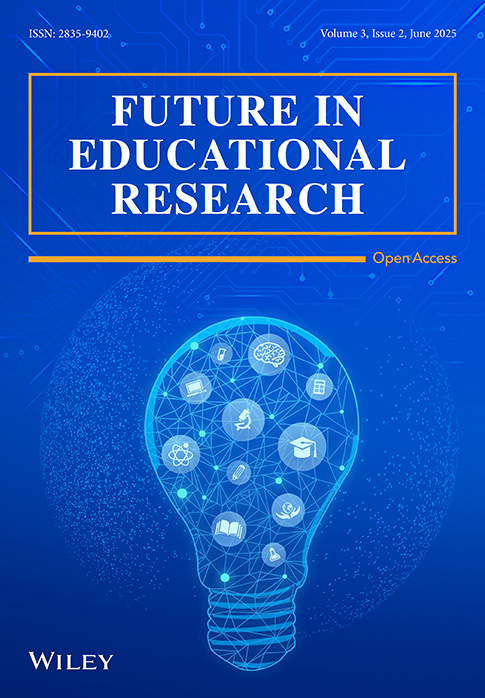Effect of virtual simulation supported museum-based learning on primary school students' multidisciplinary knowledge acquisition, learning motivation, critical thinking, creativity, and problem-solving skills in C-STEAM courses
Abstract
The purpose of this study was to investigate the effects of virtual simulation-supported museum-based learning (VSS-MBL) versus a traditional classroom on students' multidisciplinary knowledge acquisition, learning motivation, critical thinking, creativity, and problem-solving skills in C-STEAM courses. We invited 112 primary school students to participate in a series of C-STEAM lessons in both VSS-MBL (58 students) and traditional classroom settings (54 students). Students were able to interact with exhibits during their museum visit using virtual simulation technology, such as watching shadow play using AR and applying VR to draw personalized face paintings. Repeated ANOVA results showed that VSS-MBL had a more significant impact on learning motivation, critical thinking, creativity, and problem-solving skills than students learning in a traditional classroom setting. However, the significant effect on multidisciplinary knowledge acquisition was not as significant as learning in a traditional classroom environment, and there was no significant change in engineering knowledge. This study further discusses the reasons for this and provides scientific guidance for primary schools wishing to integrate C-STEAM education into their museums.
1 INTRODUCTION
STEM education was initially proposed to stimulate adolescents' passion for science and technology and to cultivate more talents with literacy in science, technology, engineering, and mathematics. On the one hand, the intrinsic characteristics of STEM education help students to acquire multidisciplinary knowledge in a systematic way. On the other hand, it helps students develop a variety of higher-order thinking through solving real-world problems. Over time, more and more people are recognizing the important value of humanities disciplines in developing 21st-century talents (Bianchi, 2016). According to Boy (2013), the arts disciplines, which are centered on creativity, should be an integral part of STEM education. In the framework for the 5Cs framework for 21st Century Key Competences, “cultural competency” focuses on learners' cultural understanding and heritage literacy, especially the inheritance and practice of the Chinese traditional culture (Liu et al.,2020). In this context, STEAM education has been proposed and C-STEAM education has been derived. Like STEAM education, C-STEAM focuses on applying interdisciplinary knowledge to solve real-world problems (Zhan & Niu, 2023). Moreover, C-STEAM has been proven to be effective in developing students' STEAM competency and traditional cultural identity (Zhan et al., 2021). Cultural competence and human-centered design in C-STEAM education that supports contextual learning and multidisciplinary perspectives should be emphasized (Zhan et al., 2023). Unfortunately, the arts or humanities are often marginalized and neglected, an issue that requires further consideration (Liu & Wu, 2022).
To promote a deeper integration of arts and cultural literacy with C-STEAM education, museums' contextual learning environments can be effectively utilized to promote C-STEAM education. As places where culture is transmitted and passed on in innovative ways, museum education provides excellent opportunities to interpret and promote visitors' understanding of the culture inherent in the venue. Learners engage in learning experiences and generate cognitive pathways in the exposure and construction of museum cultural contexts, enabling learners to complete cultural contextual experiences in composite spatial and temporal contexts and group-based interactive contexts wholeheartedly (Shao & Meng, 2023). The support of VR technology will enhance the interactive effects of history and culture in museums and create a meaningful and reliable learning atmosphere (Pagano & Cerato, 2015). In terms of the psychological mechanism of creative thinking generation, VR technology support for cultural learning environments in museums enhances students' sense of creative efficacy and fosters creative thinking by facilitating knowledge acquisition and broadening horizons (Shi & Luo, 2019).
However, the current museum education still exihibits two major types of problems: serious homogenization and detachment of the content of cooperation between museums and schools (Pan, 2022): (a) Due to the lack of professional talents, many museums still use a single and boring traditional explanation as the main learning method, which does not reflect the local cultural characteristics and mobilize the students' interest in learning. (b) When designing learning activities, museums are not able to combine the content of the lectures with the teaching materials or curriculum standards of the subjects according to the physiological and psychological characteristics of the students as professional teachers do. This disconnect between museum-based learning content and school curriculum negatively impacts learning effectiveness. In addition, technology-supported museum learning does not always have a positive effect on student learning, and the novelty of the technology can have a negative effect on students (Savela et al., 2020). The use of too much technology in museum learning can also have a negative impact on learner distraction by causing them to switch platforms frequently during the visit (Wang et al., 2023).
Nowadays, more and more museums have been built in various school systems, but how to integrate museums into the regular school curriculum still needs to be further discussed. Incorporating C-STEAM education can be an effective approach. It also helps to enhance the integration of art and STEM subjects and promotes higher-order thinking among students (Bevan et al., 2015). However, how to integrate technology-supported museum learning with C-STEAM programs needs to be further explored. The current study tried to develop C-STEAM courses based on an intangible cultural heritage museum and established virtual simulation-supported museum-based learning (VSS-MBL) model to explore ways to implement a comprehensive hands-on curriculum for museum-school integration. The focus is to research the effectiveness of museum education on the development of students' acquisition of multidisciplinary knowledge, learning motivation, critical thinking, innovativeness, and problem-solving skills and to provide a reference paradigm for the design of museum-based STEAM education.
2 LITERATURE REVIEW
2.1 C-STEAM education
There is a worldwide boom of STEM education (Zhan, Shen, & Lin, 2022), which emphasized interdisciplinary integration and convergence of the curriculum (English, 2016; Herschbach, 2011; Li et al., 2019). Within the STEM framework, science (S) stands for the domain of exploring the world by scientific inquiry. Engineering (E) and technology (T) stand for the domains of changing the world, whereas technology refers to supporting tools and engineering is regarded as the systematic solution. Mathematics (M) provides a logic and computing base for the above domains (Zhan, Shen, & Lin, 2022).When time goes by, researchers realize that STEM could not sustainably develop without arts and humanity (Boy, 2013); therefore, arts (A) has been added in the concept, which provided an interdisciplinary approach to critical areas of math, science, and arts (Quigley et al., 2017; Stroud & Baines, 2019). By integrating and merging pedagogical methods, STEAM education sought to cross disciplinary boundaries and connected disciplinary core knowledge to enhance students' higher-order thinking (Carr et al., 2018). Practically, STEAM education was claimed to be effective in the cultivation of students' craft skills (Guarrella, 2021), curiosity, and motivation (Rana & Sultan, 2021) through problem-solving, collaboration, and challenge (Limbong et al., 2019).
C-STEAM education is an outgrowth of STEAM education, which calls for interdisciplinary education on different cultural themes (Zhan et al., 2021). Aiming at cultural heritage and preservation, some countries placed more emphasis on cultural integration and humanistic orientation in STEAM education. C-STEAM emphasized common relationships among disciplines and transferring knowledge between disciplines in the cultural context (Rana & Sultan, 2021), which help to develop students' scientific and craft skills (Guarrella, 2021). For example, a Korea research team included traditional instruments and added humanities to the five STEAM disciplines (i.e., history, geography, and bibliography) (Kim, 2016). There were various case studies carried out in China too, for example, the wooden arch bridge project using mortise and tenon technology (Wu et al., 2022), the Cultural Guangzhou Sandbox project incorporating open class concept (He et al., 2022), and the case of Cantonese slang related to Guangfu culture (Huo et al., 2020). Moreover, Guan and Zhan (2021) developed a P-CAR framework that integrates positive psychology with C-STEAM education, which has been empirically proven to effectively enhance students' subjective well-being, conceptual understanding, classroom performance, and course interest.
2.2 MBL
Museums were informal learning settings where learning was intrinsically motivating and proceeded through curiosity, observation, and activity. They were generally regarded by educators as an essential part of school life and as a means of illustrating lessons on human development through support for initiatives that allowed students to learn through experience (Van Mensch & Meijer-van Mensch, 2011). Nowadays, more and more museums carried out cooperation with schools, and there were rich cooperation models between museums and schools (e.g., community-museum-schools, museum-affiliated schools, museum-led, school-led, etc.) (Yu & Wang, 2012). There were many similarities between museums and schools and both can be places to foster learners' cognitive development through play, exploration, and dialog, or with pedagogies that deliver experiential and inclusive learning opportunities (Feliu-Torruella et al., 2021). There has been a growing emphasis on the importance of museum-school cooperation and the development of educational programs that advance students' thinking through two primary pedagogical approaches: the inquiry approach and the hands-on artistic creation approach (Xu et al., 2022). These approaches provide students with unique experiential environments while reinforcing what they have learned in the classroom (Uppin & Timoštšuk, 2022). According to Bai et al. (2017), the museum education curriculum can be divided into three models: “visit + task list” (for history museums), “inquiry + discovery” (for science museums), and “guide + experience” (for various museums).However, many museums still lack precise guidance on how to effectively integrate the unique characteristics of their venues with diverse multidisciplinary learning content as well as how to cater to interdisciplinary thematic teaching and the specific needs of student development. This includes guidance on how to design and implement educational teaching activities that foster the development of critical thinking and other valuable abilities in students.
2.3 Potential benefits and challenges of MBL in C-STEAM courses
STEAM education and museum education share a common focus on hands-on, experiential learning that encourages inquiry, exploration, and critical thinking. Especially, C-STEAM education is concerned with the inheritance and promotion of cultures; thus, it fits to proceed in museums. By combining these two approaches, students might be able to connect their learning to real-world contexts and develop a deeper understanding of complex concepts in a meaningful way. Actually, there has been various examples of museum partnering with various organizations to promote STEM education (Anderson et al., 2017; Muschio et al., 2015). Studies have been conducted on the benefits of STEM learning in museums. With respect to learning motivation, museum learning environments have been found to motivate students toward STEM learning (Adams et al., 2014; Marcus et al., 2021). It has also been found that students are more likely to acquire science skills in museums, thus reinforcing their interest in scientific research (Habig & Gupta, 2021). With respect to multidisciplinary knowledge acquisition, museums' rich exhibits contain a significant amount of STEM knowledge and experiences, providing students with complementary and extended learning opportunities outside of the classroom in the formal education system (Nixon, 2021; Reiss et al., 2016; Russell et al., 2013). With respect to critical thinking, creativity, and problem solving, studies have shown that C-STEAM programs conducted in museum settings have the potential to enhance students' critical thinking, creativity, collaboration, and problem-solving skills through hands-on, inquiry-based learning experiences (Zhan et al., 2021). By interacting with exhibits and resources related to STEAM disciplines, students are able to develop a deep understanding of complex concepts and their real-world applications. This, in turn, stimulates students' curiosity and inquisitiveness and develops effective problem solvers, critical thinkers, and creative leaders. To sum up, there are natural advantages to combining museum learning with STEM education. Previous research has also shown this to have a positive impact on students' knowledge and skill formation. However, there is a lack of perspectives to analyze the learning outcomes of STEM education in museums from a technology-empowered perspective. Therefore, this study aims to explore the impact of combining VSS-MBL with STEM education.
2.4 Virtual simulation-supported MBL (VSS-MBL)
The emergence of virtual simulation technology fulfills people's desire to explore the world without leaving home. By transcending temporal and spatial constraints on human cognition, this technology enables museums to more effectively facilitate holistic personal development through educational experiences. The New Media Consortium (NMC) in the United States predicted in the Horizon Report (Museum Edition) released in 2016 that there will be six major technologies applied in museums in the field of education and interpretation in the future, including virtual reality technology, information visualization technology etc (Freeman et al., 2016). There is abundant evidence of the integration of museum learning with virtual simulation technologies in pedagogical practice. Pagano and Cerato (2015) applied a variety of digital technologies in the “Keys to Rome” exhibition at the Imperial Fora Museum to support student interaction with the exhibits, such as AR, VR, and 3D. The exhibition was organized by the Imperial Fora Museum in Rome and used a variety of digital technologies to support students' interactions with the exhibits, such as AR, VR, QR code technology, and 3D printing. It was found that the application of these technologies in museums can effectively help students to memorize and understand the content related to the exhibits and promote cultural transmission. Hammady et al. (2020) invited visitors to apply VR to assist them in visiting a history-themed museum, and a survey conducted at the end of the day found that VR can promote the development of creative thinking among visitors. Similarly, AR technology has been shown to have an enhancing effect on learners' critical thinking (Poce et al., 2019). Kaplan-Rakowski et al. (2024) took a controlled trial to explore whether highly immersive VR, tablets, and sound affect students' learning outcomes, enjoyment, sense of presence, and stimulation of interest in museums and found that VR could enhance learners' sense of presence in museums.
However, there is research feedback indicating that head-mounted VR devices make people feel physically uncomfortable, such as dizziness and nausea (Rhee, 2019). There are also studies that concluded that virtual simulation technology does not necessarily improve learners' learning performance (Savela et al., 2020). The above studies have been analyzed and found that combining museum learning with virtual simulation technology is feasible and has a rich research practice as a theoretical basis. Some studies have also shown that virtual simulation-supported museum learning can enhance learners' learning performance. But most of the research focuses on the feasibility and impact on learners of integrating museum learning with virtual simulation technology. It has not been implemented in conjunction with specific teaching methods or teaching models, which is not conducive for further integration with the regular school curriculum. More importantly, the effectiveness of virtual simulation-supported museum learning on students is controversial. To sum up, there are inconsistent arguments on the effect of VSS-MBL on primary school students' multidisciplinary knowledge acquisition, learning motivation, critical thinking, creativity, and problem-solving skills in a C-STEAM course. Therefore, this paper aims to examine the effect of VSS-MBL on primary school students' multidisciplinary knowledge acquisition, learning motivation, critical thinking, creativity, and problem-solving skills in a C-STEAM course.
2.5 Research objectives and research questions
-
RQ1: Does MBL integrated with C-STEAM have a positive impact on primary school students' multidisciplinary knowledge acquisition?
-
RQ2: Does MBL integrated with C-STEAM have a positive impact on primary school students' learning motivation?
-
RQ3: Does MBL integrated with C-STEAM have a positive impact on primary school students' critical thinking?
-
RQ4: Does MBL integrated with C-STEAM have a positive impact on primary school students' creativity?
-
RQ5: Does MBL integrated with C-STEAM have a positive impact on primary school students' problem-solving skills?
3 METHOD
3.1 Participants
A total of 112 students from a primary school in southern China participated in the study. There were 58 students learning in the museum (including 26 girls and 32 boys) and 54 students learning in the classroom (including 28 girls and 26 boys). They were all students in a regular fourth grade class. All participants have learned programming courses one semester previously, so they all had basic computer skills and programming knowledge. And they had a similar level of knowledge. Primary school students at the age of 10–11 were turning from figurative to abstract logical thinking. Therefore, it was an important period to develop their higher order abilities such as critical thinking, creativity, and problem-solving skills.
3.2 The VSS-MBL intervention
According to Dewey (1986), “thinking originates from direct experience,” and his “Five Steps to Think” provided a practical guideline for museum education (Hein, 2016). Based on the C-STEAM pedagogy, and referring to the features of museum education, this study proposed a VSS-MBLMBL model with three learning stages (as shown in Figure 1). The C-STEAM course took place at the intangible cultural heritage museum on campus. The first stage is for museum-based situational perception and inquiry, where students interact with exhibits in the museum with the support of a VSS program that promotes the understanding of the cultural context and problem identification (as shown in Figure 2). The second stage is for classroom-based creative production, which guides students to transform the internalized knowledge into visual products through graphical programming and promotes their cultural connection. The third stage is presentation and expression, and the museum has a theater that is an excellent venue for student presentations. Students can present and summarize their creations and experiences at the museum and receive feedback from the public.
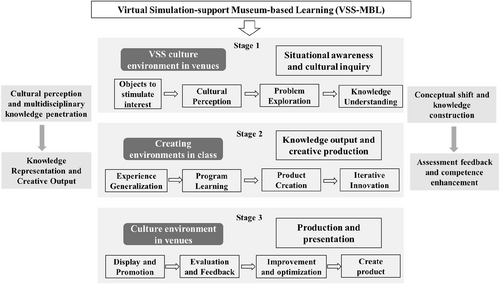
Virtual simulation-support museum-based learning (VSS-MBL) model.
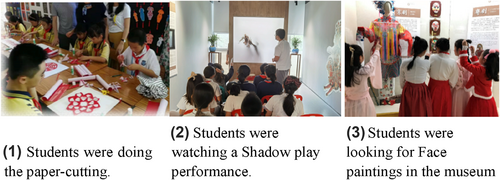
Students in the treatment group were experiencing the thematic culture.
-
The “finding intangible cultural heritage in the museum” module requires students to follow the clues (e.g., riddles) in the app to find out the corresponding exhibits in the museum and to acquire knowledge by visiting the exhibits in the museum to obtain the relevant information. In order to solve the problem of students forgetting the knowledge after visiting the exhibits, students need to complete the corresponding knowledge test after visiting the exhibits in order to provide feedback on their knowledge level at the end of the museum visit (as shown in Figure 3(2)).
-
The “intangible cultural heritage experience and creation” module provides students with a personalized creation platform through virtual simulation such as AR and VR so that they can create personalized intangible cultural heritage products. For example, in the theme of face painting, students can freely choose any color to paint their own faces, or they can also paint theatrical faces according to the traditional style (as shown in Figure 3(3)). In the shadow play theme, students can watch shadow plays through AR, bringing a new and different feeling (as shown in Figure 3(4)). In the paper cutting theme, students can choose different folding methods and pattern styles to cut colorful paper cutting (as shown in Figure 3(5)). After completing the activities in the program, students can earn badges and the time spent is automatically recorded. A ranking list is generated based on the number of badges earned and time spent (as shown in Figure 3(6)).

Virtual simulation software “Vanishing intangible heritage.”
3.3 The lesson plan
The course lasted for 9 weeks with three rounds of theme-based instructions. Based on MBL, the teaching sessions were divided into three stages, each lasting one lesson (Specific course content is shown in Table 1). The first and third stages took place in the museum, which allowed students to perceive and experience the culture and took full advantage of museum-based exploration. The second stage was held in a multimedia classroom in order to accommodate programming education. Table 2 summarized the curriculum's multidisciplinary knowledge.
| Cultural subjects | Content | MBL task |
|---|---|---|
| Shadow play | Principles of shadow play imaging, historical stories, knowledge of theater music, and determining position using coordinate representations |
|
| Face- painting | Principles of face-changing, historical stories of face painting and drawing skills, and image panning |
|
| Paper- cutting | Historical origins of paper cutting, changes in spatial structure, knowledge of axial symmetry |
|
| Cultural subjects | Science (S) | Technology (T) | Engineering (E) | Art (A) | Mathematics (M) |
|---|---|---|---|---|---|
| Shadow play | The scientific principles of shadow play pinhole imaging, the use of linear propagation of light, and other related scientific knowledge. | Use the computer network to find the required information and use the computer to complete code programming to achieve animation and game effects | Integrate mathematical and programming knowledge to complement the completion of a thematic programming case on shadow puppetry and propose optimization solutions | The history of shadow puppetry, knowledge of opera music, art knowledge of the shape and color design | Mathematical operations involved in programming; coordinate axis quadrants and coordinate representation of object positions |
| Face-painting | Principles of face-changing stunt magic | Use VR technology to gain extended knowledge and complete tasks | Integrating mathematical and programming knowledge to complement and optimize programming cases | Historical origins of face-painting, basic methods, steps of face-painting, and the art of color matching in face-painting (three primary colors) | Knowledge of panning involved in programming characters to achieve motion effects |
| Use the computer to complete code programming to achieve animation and game effects | |||||
| Paper-cutting | The science of deformation from a two-dimensional planar structure to a three-dimensional planar | Use VR technology to gain extended knowledge and complete tasks | Integrate mathematical and programming knowledge to optimize programming cases and propose optimizations to the work of others | Historical origins and uses of paper-cutting, pattern design, and color scheme of paper-cutting | Knowledge of coordinates and knowledge of symmetry of figures |
| Use the computer to complete code programming to achieve animation and game effects |
4 MEASURE INSTRUMENTS
4.1 Multidisciplinary knowledge acquisition evaluation
Students' knowledge acquisition level was assessed by a knowledge test from a multidisciplinary perspective in five dimensions. Based on the curriculum standards and teaching content, we have developed a multiknowledge level test and invited a number of educational experts to evaluate the questions. We measured the degree of students involving scientific principles, the accuracy of presenting scientific principles, and the proficiency of using information technology tools. A total of 100 points were scored based on 10 test items. The validity of the evaluation was examined using SPSS 25. The results of the reliability analysis showed that Cronbach's alpha of the test evaluation form was 0.813, and each dimension had a Cronbach's alpha over 0.7, indicating that it was highly reliable and stable. The KMO value was 0.712, which was in the range of 0.7–0.8, indicating the test had good validity.
4.2 Learning motivation survey
Students' learning motivation was measured by the course interest survey proposed by Keller (2009). The survey evaluated students' motivation to learn on four dimensions: attention, relevance, confidence, and satisfaction. And it was in the form of a five-point Likert scale from 5 (strongly agree) to 1 (strongly disagree) with 40 items. Results of the reliability test showed that Cronbach's alpha was 0.918, indicating a good reliability and stability of the scale; the KMO value was 0.827, indicating it was valid.
4.3 Critical thinking test
Students' critical thinking was measured using the Chinese version of the California Critical Thinking Skills Test (CCTST) as revised by Luo & Yang. (2002). The scale is a multichoice scale. Based on the critical thinking theory developed by the American Psychological Association (APA) in 1990, it consists of five subscales: analyzing, evaluating, reasoning, inductive reasoning, and deductive reasoning. The retest reliability was 0.63, P < 0.01, and the two half-score correlation coefficients were 0.75 and 0.80, with p-values less than 0.01, which proved that the revised CCTST has good reliability.
4.4 Creativity assessment
Students' creativity was measured using Williams' Creativity Assessment Package. It is in the form of a five-point Likert scale with four sub-dimensions (i.e., curiosity, imagination, challenge, and risk-taking). It measures important thinking traits and personality potential in the development of an individual's creativity and is often used to predict an individual's creative potential. The reliability analysis of the questionnaire showed a Cronbach's alpha value of 0.81 and a KMO value of 0.785 (Zhan, Shen, Xu, et al., 2022).
4.5 Problem-solving skills measurement
Students' problem-solving skills were measured by the problem-solving quality questionnaire (He, 2021) in the form of a five-point Likert scale, which measured students' problem-solving skills in the four dimensions (i.e., inquiry and comprehension, qualitative and formative, planning and implementation, and reflection and monitoring). The questionnaire has good reliability with a Cronbach's alpha value of 0.916.
4.6 Data analysis
Before the course, we distributed questionnaires to collect students' pretest data to ensure that there were no significant differences in students' multidisciplinary knowledge acquisition, motivation, critical thinking, creativity, and problem-solving abilities before the experiment. At the middle and end of the course, we again distributed questionnaires to collect students' data to observe changes in students' relevant abilities. All data in this study were analyzed using SPSS 25 for descriptive statistics. In order to compare the differences in the changes in multidisciplinary knowledge acquisition, learning motivation, critical thinking, creativity, and problem-solving skill during the C-STEAM courses between the museum environment and the classroom environment, a one-way repeated measures ANOVA was conducted on each of the five dependent variables to monitor the changes that occurred in each of the five independent variables over the course of the experiment.
5 RESULTS
According to the data collected from the multidisciplinary knowledge acquisition test, learning motivation questionnaire, critical thinking scale, creativity test scale and problem-solving skills scale, a one-way repeated measures ANOVA was conducted to analyze the data from the different measures of the students in the C-STEAM courses in the museum environment and in the classroom environment. The results of the ANOVAs and spherical test for the dependent variables are presented in Table 3.
| Group | Item | Time | Source: stage*group | |||||
|---|---|---|---|---|---|---|---|---|
| S1 | S2 | S3 | F | P | η2 | |||
| Knowledge acquisition | 1 | M(SD) | 52.85 (5.527) | 53.17 (5.183) | 53.48 (4.938) | 291.478 | 0.000 | 0.756 |
| 2 | M(SD) | 55.04 (4.381) | 57.58 (4.021) | 61.94 (3.711) | ||||
| Learning motivation | 1 | M(SD) | 15.94 (2.898) | 16.00 (2.813) | 16.04 (2.783) | 40.227 | 0.000 | 0.3 |
| 2 | M(SD) | 16.12 (2.734) | 16.67 (2.309) | 17.69 (1.847) | ||||
| Problem-solving skills | 1 | M(SD) | 15.31 (3.447) | 15.42 (3.325) | 15.48 (3.313) | 28.596 | 0.000 | 0.233 |
| 2 | M(SD) | 15.58 (3.045) | 16.25 (2.338) | 17.35 (1.839) | ||||
| Critical thinking | 1 | M(SD) | 14.94 (3.021) | 14.98 (2.928) | 14.98 (2.928) | 36.753 | 0.000 | 0.281 |
| 2 | M(SD) | 15.04 (2.858) | 15.25 (2.686) | 16.48 (2.073) | ||||
| Creativity | 1 | M(SD) | 9.76 (1.272) | 9.852 (1.188) | 10.056 (1.156) | 2.322 | 0.000 | 0.024 |
| 2 | M(SD) | 10.59 (1.155) | 10.724 (1.225) | 11.552 (1.231) | ||||
5.1 Multidisciplinary knowledge acquisition
A single-group analysis of the collected data yielded a test of the variance matrix on the overall scores, resulting in p-values of less than 0.05 for both the total knowledge level and each dimension. This indicates that the data did not satisfy the assumption of a spherical distribution of the covariance matrix; therefore, Greenhouse–Geisler correction was used for statistical adjustment in repeated-measures ANOVA, helping to ensure the accuracy and reliability of the statistical results. Students' multidisciplinary knowledge acquisition level and its dimensions as dependent variables, time as a within-group variable, and the group as a between-group variable. As shown in Table 3, total scores (p < 0.01), S (p < 0.01), T (p < 0.01), A (p < 0.01), and M (p < 0.01) had significant group main effects. But E (p = 0.193 > 0.05), for the interaction between time and group, was not significant. The above data illustrated that VSS-MBL significantly affected students' multidisciplinary knowledge acquisition.
As can be seen in Table 4, there was a significant interaction along time and group for the total score (p < 0.01). For the discipline dimension, there was a significant interaction between time and group for knowledge in all disciplines, except for the engineering knowledge group, which did not have a significant effect with time. A simple effects analysis (Figure 4) revealed that, at all three learning stages, the control group exhibited significantly higher levels of knowledge acquisition compared to the treatment group with an accelerated rate of increase over time.
| Subjects | Group | Item | Stage | Source: stage*group | ||||
|---|---|---|---|---|---|---|---|---|
| S1 | S2 | S3 | F | P | η2 | |||
| S | 1 | M(SD) | 10.42 (0.711) | 10.65 (2.309) | 11.73 (0.844) | 58.672 | 0.024 | 0.384 |
| 2 | 9.71 (1.304) | 9.77 (1.207) | 9.88 (1.064) | |||||
| T | 1 | M(SD) | 11.46 (1.543) | 12.37 (1.315) | 13.38 (1.104) | 89.845 | 0.044 | 0.489 |
| 2 | 11.17 (1.767) | 11.23 (1.666) | 11.25 (1.677) | |||||
| E | 1 | M(SD) | 10.46 (1.501) | 10.63 (1.393) | 10.67 (1.342) | 36.753 | 0.193 | 0.281 |
| 2 | 11.46 (1.543) | 12.37 (1.315) | 13.38 (1.104) | |||||
| A | 1 | M(SD) | 10.46 (1.501) | 10.63 (1.393) | 10.67 (1.342) | 82.721 | 0.000 | 0.468 |
| 2 | 10.46 (1.501) | 10.63 (1.393) | 10.67 (1.342) | |||||
| M | 1 | M(SD) | 11.88 (1.482) | 12.92 (1.069) | 13.98 (1.176) | 86.813 | 0.000 | 0.48 |
| 2 | 11.56 (1.749) | 11.67 (1.655) | 11.71 (1.584) | |||||
| Total score | 1 | M(SD) | 55.04 (4.381) | 57.58 (4.021) | 61.94 (3.711) | 291.478 | 0.000 | 0.756 |
| 2 | 52.85 (5.527) | 53.17 (5.183) | 53.48 (4.938) | |||||
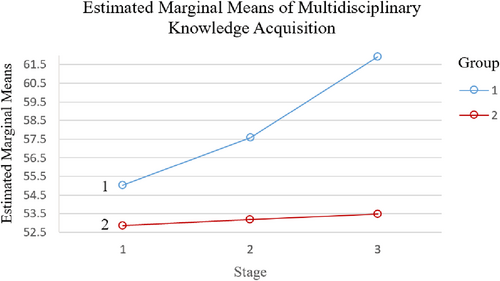
The trajectory of the total score of knowledge acquisition levels.
5.2 Learning motivation
A repeated-measures ANOVA was conducted using the learning motivation score as dependent variables with time as the within-group variable and group as the between-group variable. Results revealed significant main effects of MBL on learning motivation (p = 0 < 0.05). The interaction between time and group was significant. Students' learning motivation in the treatment group was significantly higher than that in the control group at the second and third time points. The trend increased when time goes by. Figure 5 presents the trajectory of the two groups in terms of students' learning motivation.
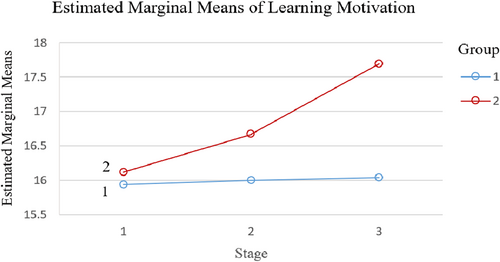
Score trajectory of learning motivation.
5.3 Critical thinking
A repeated-measures ANOVA was conducted using the critical thinking score as dependent variables with time as the within-group variable and group as the between-group variable. Results revealed significant main effects for critical thinking (p = 0 < 0.05). Students' critical thinking in the treatment group was significantly higher than that in the control group at the second and third time points. Moreover, the critical thinking skills of the experimental group gradually increased from Stage 1 to Stage 2, with this increase being more significant between Stages 2 and Stage 3. Figure 6 presents the trajectory of the two groups in terms of students' learning motivation.
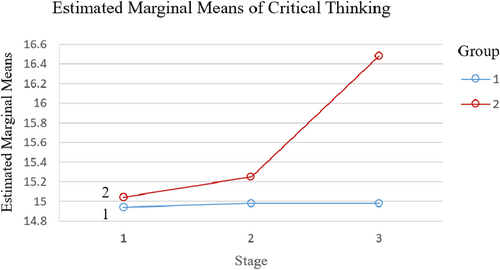
Score trajectory of critical thinking.
5.4 Creativity
A repeated-measures ANOVA was conducted using the creativity score as dependent variables, with time as the within-group variable and group as the between-group variable. Analysis of the data revealed creativity (p = 0 < 0.05) had a significant group main effect. As can be seen in Table 2, the interaction between time and group was not significant. The above data indicate that creativity changed significantly between the three time points of the pretest and posttest. Figure 7 presents the trajectory of the two groups in terms of creativity scores.
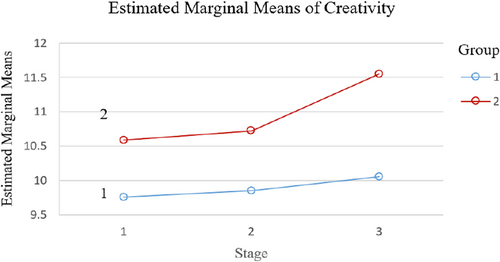
Score trajectory of creativity.
5.5 Problem-solving skills
A repeated-measures ANOVA was conducted using the problem-solving skill scores as dependent variables, with time as the within-group variable and group as the between-group variable. Analysis of the data revealed significant main effects for problem-solving skills (p = 0 < 0.05). As can be seen in Table 2, the interaction between time and group was significant. The above data indicate that problem-solving skills changed significantly between the three time points of the pretest and posttest. Figure 8 presents the trajectory of the two groups in terms of problem-solving skill scores.
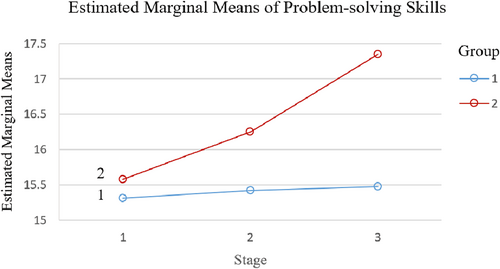
Score trajectory of problem-solving skills.
6 DISCUSSION
6.1 Multidisciplinary knowledge acquisition
With respect to RQ1, the experimental results showed that both museum and classroom programs facilitated student knowledge acquisition, but students acquired knowledge better in traditional classrooms. This phenomenon is due to several reasons: First, VR technology provides interactive educational environments to support experiential learning in museums, facilitating active student acquisition of student knowledge (Zhou et al., 2022). Second, classroom teaching is efficient in the knowledge transfer process and ensures rapid knowledge transfer (Zhou & Guo, 2022). Therefore students in both ways are favored to acquire multidisciplinary knowledge, whereas exhibits in museums can only attract students to stay at a shallow level of understanding and acquire a limited amount of factual information. What is more, museum education lacks targeted professional services, and classroom teaching is prone to experience frustration with museum teaching due to lack of support. In this case, visiting museums becomes a simple extracurricular activity for students, making it difficult to integrate the learning experience into the acquisition of course knowledge (Bao, 2011). As a result, VSS-MBL is less desirable than learning in a traditional classroom setting. It is noteworthy that there was no significant difference in the engineering competence of the students in the two learning styles. One possible explanation is related to the creation of problem situations for the learning process. An important process for developing engineering competence is to define problems by creating real-world problem situations and thus defining problems (Fan & Yu, 2017). Students' daily lives are less exposed to contents related to intangible cultural heritage, which is not conducive to students' ability to make connections between problem situations and real-world life experiences (Chiang et al., 2020). Therefore, in future research, we can think about how to create C-STEAM learning theme contexts that are more closely connected to students' daily lives.
6.2 Learning motivation
With respect to RQ2, findings show that the combination of museum learning and C-STEAM increased primary school students' learning motivation. In terms of learning motivation, the three stages of instruction developed by VSS-MBL were based on the cultural context of the museum, which provided students with an authentic learning experience and thus increased their interest in learning. The activities in the mini program support students to interact with the exhibits, which likewise motivates students' learning motivation. This is consistent with existing research findings. The fun of VR and the variety of museum exhibits inspired student engagement. (Puig et al., 2020; Tanabashi, 2021). Classroom observations showed that in the first stage of instruction, students' interest in learning about museums was high, but they had less knowledge of intangible cultural heritage. Students may need more help from the teacher. With the addition of learning scaffolds in the second stage, students gained a deeper understanding of the cultural context and increased their efficiency in completing programming assignments. In Stage 3, students were able to present their programming work more fluently because they all felt “interested in learning.” Therefore, setting graded questions and providing learning scaffolds are important to maximize student learning.
6.3 Critical thinking
With respect to RQ3, the results of the research showed a significant improvement in students' critical thinking before and after the experiment. In the second stage of VSS-MBL, students transformed their internalized knowledge into visual products through graphical programming. The teacher provided strategic scaffolding that effectively guided the students' metacognitive activities and iterative updating. In Stage 3, students presented the results of Stage 2 to the teacher and other students. In VSS-MBL, students evaluate and reflect on their own work. The work of others is analyzed and evaluated, and the basis for the evaluation is explained. These learning behaviors apply and reinforce critical thinking (Poce et al., 2019). This result indicates that VSS-MBL can promote the development of critical thinking among students in C-STEAM (Hu & Hwang, 2024).
6.4 Creativity
With respect to RQ4, the results of the study showed a significant increase in students' creativity through the MBL model. This was consistent with the findings that STEAM education (Lin et al., 2022; Zhan, Shen, Xu, et al., 2022) and VSS-MBL can enhance students' creativity. In the first stage, the museum exhibits provided the cultural knowledge background for students to utilize their imagination, and the application software built a platform for students to create freely to support the development of their creativity. The evaluation and modification of the work in the second and third stages also stimulated students' creativity. It is through thinking activities such as reasoning and categorizing that the brain creates experiences that lead to higher-order thinking and further motivate students to take action, which again leads to the development of thinking (National Research Council, 2000).
6.5 Problem-solving skills
With respect to RQ5, the results of the study confirm the positive impact of C-STEAM courses based on VSS-MBL on primary school students' problem-solving skills. This is consistent with previous research reporting that learning in VSS-MBL helps promote the development of students' problem-solving skills (Hu & Hwang, 2024). In the first stage, students use software to interact with exhibits, create problem situations, and ask questions in the Discovery Museum. For example, they visit a museum exhibit featuring shadow play to learn about the history and art of shadow play. Ask the exploratory question, “How do you program a program related to shadow play? For example, a game or an animation.” In the first stage, they learned about the history of shadow play and watched a shadow play at the museum. In the second stage, students try to use programming to come up with solutions through understanding, analyzing, and reasoning. When students are confused, the teacher provides strategic scaffolding to improve their problem-solving skills (Ma et al., 2022). In the third stage, other people's evaluations can be used as a pre-experience for the students' next problem-solving session.
7 CONCLUSION
This study examines the impact of an instructional model that integrates C-STEAM education, VSS-MBL on students' acquisition of multidisciplinary knowledge, learning motivation, critical thinking, creativity, and problem-solving skills. Through three rounds of nine-week sessions (the themes were shadow play, face painting, and paper cutting), we analyzed the questionnaires and artwork completed by the students. The results showed that VSS-MBL greatly improved students' learning motivation, critical thinking, creativity, and problem-solving skills. However, VSS-MBL was less effective than classroom learning in multidisciplinary knowledge acquisition. There was no difference in the learning outcomes of the two groups of students in terms of engineering knowledge. At the theoretical level, the VSS-MBL proposed in this study can be used as a paradigm for the integration of C-STEAM and museum learning. The VSS-MBL divides the teaching and learning into three stages: in the first stage, students use the software to interact with each other, create contexts, and engage in cultural explorations in the museum. In the second stage, students apply what they have learned to solve problems in the classroom. In the third stage, students were required to present their work to others in the museum. The results of this study confirm the feasibility of VSS-MBL and validate the role of museum environments in increasing students' motivation, critical thinking, creativity, and problem-solving skills.
8 IMPLICATION AND FUTURE STUDY
Museum-based STEAM education is of great value for innovative talent cultivation. The research constructed VSS-MBL, a C-STEAM curriculum model based on virtual simulation technology. The model is based on a three-stage teaching process, incorporating museums and multimedia classrooms, making full use of the multiform resources in the informal education environment, integrating culture, technology, engineering, art, science, and other disciplines, and performing targeted teaching sessions around the four dimensions of higher-order thinking skills, with three rounds of research and iterative optimization of the model framework. The results demonstrate how the model can refine students' higher-order thinking skills, stimulate their multidisciplinary integration, and promote multilevel integration of humanities and technology. VSS-MBL fosters students' understanding of cultural connotations and multidisciplinary integration and can serve as an effective reference paradigm for integration with STEAM education. It provides a typical example for future research on the museum-based instructional model and STEAM integration.
However, due to space constraints, this study did not further investigate the effect of individual differences (e.g., gender) on the dependent variable, and the correlation between the independent variables was not explored. This will be our next research program. In addition, future study could consider the following potential directions. First, C-STEAM is a special kind of STEM education in which the relationship between creativity and cultural inheritance should be paid attention to. It would be interesting to examine the correlation of students' cultural understanding and creativity in the MBL process. Second, students developed their higher-order thinking skills (e.g., critical thinking, creativity, problem-solving skills, etc.) in a relatively longer period in a dynamic mechanism. Therefore, longitudinal study is suggested in the future study to arrive at in-depth findings of cultivating students' higher-order ability in MBL. Finally, future pedagogical models that combine AI with C-STEAM education and museum learning and their impact on student learning outcomes could also be explored.
AUTHOR CONTRIBUTIONS
Lixia Luo and Zehui Zhan identified research ideas, designed and facilitated this research, wrote the draft, and made substantial revisions to this work. Lixia Luo and Wenyao Shen completed the literature review, data analysis, and conclusion writing for the article. Qi Ye designed experiments, lessons, and data collection. Zehui Zhan and Wenkai Lin suggested revisions to the article.
ACKNOWLEDGMENTS
This research was financially supported by the National Natural Science Foundation in China (62277018; 62237001), Ministry of Education in China Project of Humanities and Social Sciences (22YJC880106), the Major Project of Social Science in South China Normal University (ZDPY2208), the degree and graduate education reform research project in Guangdong (2023JGXM046), Guangdong Province Philosophy and Social Science Planning 2020 Project “Research on the Training Mechanism of STEM Teachers in Primary and Secondary Schools in Guangdong, Hong Kong, and Macao Greater Bay Area” (GD20CJY39).
CONFLICT OF INTEREST STATEMENT
Zehui Zhan is a member of the editorial board of FER and the corresponding author of this article. To minimize bias, she was excluded from all editorial decision-making related to the acceptance of this article for publication.
ETHICS STATEMENT
All subjects gave their informed consent for inclusion before they participated in the study. Informed consent was also obtained from the participants or minor(s)' legal guardian for the publication of any potentially identifiable images or data included in this article. The study was conducted in accordance with the Declaration of Helsinki, and the protocol was approved by the Institutional Research Ethics Committee.
ETHICS, CONSENT AND PERMISSIONS
The students' parents/teachers had read the informed consent form for the research experiment, had been informed about the purpose, content, and rights and obligations of both parties, and had given permission for their child to participate in this study under the supervision of the principal investigator.
CONSENT TO PUBLISH
For the publication of students' data (including pictures) in the article, it had confirmed that the consent of the students' parents/teachers had been obtained.
Biographies

Lixia Luo is a master's degree candidate in the School of Educational Information Technology, South China Normal University. Her main research interests are C-STEAM education, computational thinking development, and information technology education in primary and secondary schools.
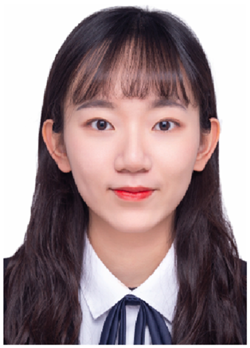
Wenyao Shen is an information technology teacher at Shenzhen Academy of Educational Sciences Experimental School (Guangming) and an excellent tutor in provincial science and innovation competitions. Focusing on the teaching of science and innovation education, she was awarded the first prize in the national “Tian Jiabing Cup” Master of Education Teaching Skills Competition, the first prize in the Guangdong Province Undergraduate College Teacher Training Skills Competition, the first prize in the Shenzhen AI Empowerment Competition and was awarded the title of “Shenzhen Craftsman,” and the title of “Shenzhen Artificial Intelligence Quality Lesson Example Competition” in Shenzhen. First prize of Shenzhen Artificial Intelligence Quality Class Competition. She has guided many students to win the first prize in Brain Science Robot Competition and Drone Competition at national, provincial, and municipal levels for more than 20 times. She has participated in 5 national, provincial, and ministerial level projects and published 6 papers in SSCI journals, international journals, international conferences, etc. She owns 2 intellectual property patents and 2 software copyrights.
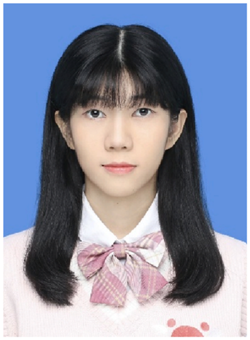
Qi Ye is an undergraduate student at the School of Education and Information Technology, South China Normal University. Her main research interests are C-STEAM education and information technology education in primary and secondary schools.

Zehui Zhan (Ph.D.) is the outstanding professor in South China Normal University. She is also the Youth Pearl River Scholar, Hong Kong Scholar, and PI of the smart educational equipment industry–university–research cooperation base, associate director of the artificial intelligence and smart education Key Lab, and associate director of Guangdong Educational Evaluation Big Data Engineering Technology Research Center. Her doctoral dissertation has been nominated as the national 100 excellent doctoral dissertations in China. She has published more than 120 papers in the field and got other honors such as the annual award of youth excellent universities teacher from Fok Yingdong Education Foundation and the Ministry of Education in China, the title of best teachers in South China Normal University, and the first prize of national education software competition. Her major research interests include STEM education and learning science.

Wenkai Lin is an associate researcher and master's supervisor who is currently the deputy director of the Institute for Advanced Studies in Humanities and Social Sciences at South China Normal University (SCNU) and the deputy director of the Hong Kong and Macao Research Center of SCNU. He is also an executive member of the Global Council for Science Education, executive director and academic member of the Professional Committee on Education Policy and Planning of the China Society for Educational Development Strategy, and executive director and secretary-general of the Research Sub-committee on Chinese-Foreign Cooperative Studies of the Guangdong Society of Higher Education. His main research areas are education policy, teacher education, curriculum and teaching, education informatization, and STEM education.
Open Research
DATA AVAILABILITY STATEMENT
The data that support the findings of this study are available on request from the corresponding author. The data are not publicly available due to privacy or ethical restrictions.



